What is a Transfer-on-Death Deed?
A Transfer-on-Death Deed (TOD deed) is a legal document that allows an individual to transfer real estate property to a designated beneficiary upon the owner's death. This type of deed bypasses the probate process, making it a convenient option for those who want to ensure their property goes directly to their chosen heirs without additional legal complications.
How do I create a Transfer-on-Death Deed?
To create a Transfer-on-Death Deed, you will need to fill out the appropriate form, which can typically be obtained from your state’s real estate or probate office. You must include details such as the property description, the name of the beneficiary, and your signature. It's important to have the deed notarized and recorded with the local county recorder's office to make it legally binding.
Can I change or revoke a Transfer-on-Death Deed?
Yes, you can change or revoke a Transfer-on-Death Deed at any time while you are alive. To do this, you simply need to create a new deed that either names a different beneficiary or states that the previous deed is revoked. Again, this new deed must be properly signed, notarized, and recorded to take effect.
What happens if the beneficiary predeceases me?
If the designated beneficiary passes away before you do, the property will not automatically transfer to them. Instead, the property will typically become part of your estate and will be distributed according to your will or, if there is no will, according to state intestacy laws. It's a good idea to regularly review your beneficiaries to ensure your wishes are accurately reflected.
Are there any tax implications with a Transfer-on-Death Deed?
Generally, there are no immediate tax implications when you create a Transfer-on-Death Deed. However, the property may be subject to capital gains taxes when the beneficiary sells it. Additionally, the property may be included in your estate for estate tax purposes. It’s wise to consult a tax professional for personalized advice regarding your specific situation.
Is a Transfer-on-Death Deed the right choice for everyone?
A Transfer-on-Death Deed can be a beneficial tool for many individuals, but it may not be suitable for everyone. Consider your unique circumstances, such as the size of your estate, your family dynamics, and your overall estate planning goals. Consulting with a legal or financial advisor can help you determine if this option aligns with your needs.
